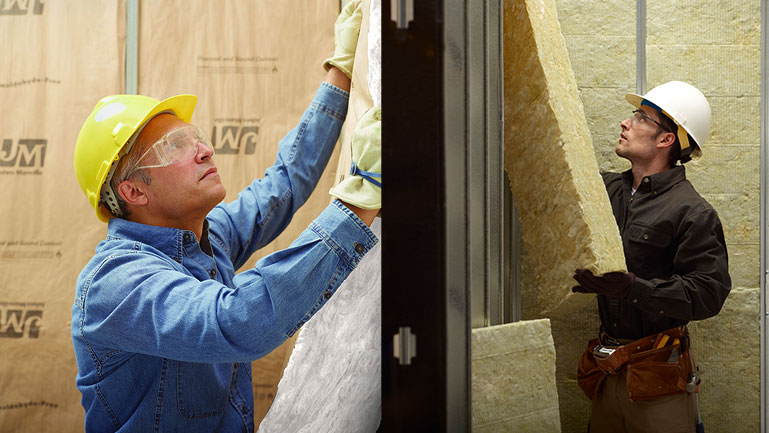When it comes to insulating residential wall cavities and attic spaces, two of the most common insulation choices are fiberglass and mineral wool batts. While both insulations are excellent choices, understanding the benefits of both materials can be helpful in making the right choice based on the requirements of your building project. The chart below compares fiberglass to mineral wool, followed by a more detailed description of each category below.

THERMAL PERFORMANCE
The primary reasons people choose to insulate are for thermal and acoustical control. For both of these characteristics, mineral wool has slightly better performance than fiberglass. For example, JM’s mineral wool batt, TempControl®, offers an R-15 at 3.5 inches, while JM’s fiberglass batts offer an R-13 at the same thickness.
INSULATION WEIGHT
Notably, while you can get a higher R-value out of mineral wool, the material is denser than fiberglass – so, it weighs more. In applications where you might need a very robust R-value, such as an R-49, the weight of the mineral wool would be significantly greater than that of the fiberglass. As a result, in applications like an attic, where the insulation will be resting directly on the gypsum board, the weight of mineral wool could be prohibitive, making fiberglass a better choice.
SOUND CONTROL
In terms of acoustics, mineral wool has marginally better sound control properties; however, the difference in acoustical performance is so minimal that humans would not be able to distinguish a difference between the two materials in a wall cavity. Both fiberglass and mineral can be used in a variety of assemblies to meet specific Sound Transmission Class (STC) requirements.
FIRE RESISTANCE
In addition to thermal and acoustical performance, many people make insulation material selections based on fire protection. While, both unfaced fiberglass and unfaced mineral wool are noncombustible and help delay the spread of fire, mineral wool does have a much higher melting point than fiberglass, and as such it is often considered the more fire-resistant material.
INSULATION FACING & MOISTURE CONTROL
When it comes to water vapor, both materials would need a facing to prevent vapor drive; however, mineral wool does not come with a facing. As a result, if inhibiting vapor drive and condensation are a priority, a faced fiberglass solution may be a better choice than an unfaced mineral wool alternative with a separate vapor barrier.
INSULATION HANDLEABILITY
Finally, installers should consider their preferences in handling the materials. The lower density fiberglass tends to be much more flexible. It is worth noting that despite its flexibility, stable, bonded glass fibers will not slump within the wall cavity, settle or break down in normal applications. In contrast to the flexibility of fiberglass, mineral wool is much more rigid because of its density. Some installers prefer the rigidity of mineral wool to the flexibility of fiberglass. Handling preferences can vary among installers, and in this category, it comes down largely to personal preference.
IDEAL USE
While both mineral wool and fiberglass can be used in very similar applications, there are some applications where one is more common than the other. Mineral wool is commonly used to insulate exterior walls, basements, and heated crawl spaces. It can also be used in continuous insulation applications. Fiberglass is typically used to insulate interior and exterior walls, basements, garages, and attics, but it is not used as continuous exterior insulation.
Both mineral wool and fiberglass are excellent home insulations. To learn more about insulation products from Johns Manville, visit our website.

